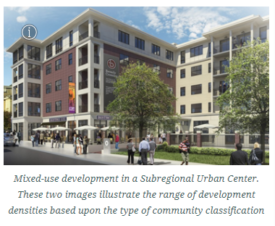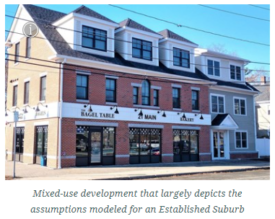What can you do with half-empty parking lots at struggling strip malls and shopping centers?
A lot, according to a report released last month by Boston’s Metropolitan Area Planning Council. MAPC’s analysis of the region’s 3,024 strip malls found that redeveloping just the best suited ten percent of them per town into mixed-use housing and commercial space could provide 125,000 new homes for the Boston metro region.
This change alone could entirely fulfill the need for 120,000 to 140,000 new multi-family homes that the regional planning agency has estimated it must add by 2030 to keep pace with demand.
These figures are also roughly equivalent to the need in Oregon, where chronic underproduction of housing has resulted in a shortage of 140,000 homes. As cities in the Pacific Northwest grapple with how to accelerate new home construction, this report offers a compelling strategy to consider.
The Woburn example
The MAPC report highlights the example of the Woburn Mall, in Woburn, a town of about 41,000 residents 12 miles from downtown Boston. When developers purchased the mall in 2017, two-thirds of its retail spaces were vacant. Today, the transformed “Woburn Village” sports a multi-family building with 350 new homes. Twenty-five percent of them are reserved for people making no more than 80 percent of the median income. The project also preserved commercial space for existing retailers: Market Basket, DSW, TJ Maxx, and HomeGoods. Planners arranged new stores and restaurants in a walkable grid, splitting up the parking lot. This property, like nearly a third of strip mall locations in the Boston region, stood within a half-mile of a regional transit center, or about a 10-minute walk, making it easier for residents or visitors to forego a vehicle if they wished.
2017 aerial image of Woburn Shopping Mall from Google Earth (left), “Bird’s eye view of development” by Amenta / Emma Architects, PC (right).
“While stories like this are still uncommon across the region, the opportunities for them are widespread,” the report reads. According to the analysis, each municipality assessed had an average of 66 football fields’ worth of land devoted to strip malls. That kind of widespread opportunity has huge implications for suburban neighborhoods that currently have limited housing options, especially smaller and less expensive homes.
“Most suburban communities already have so little multi-family housing that there are few places for older residents to downsize locally, and few places for younger residents not ready to purchase a single-family home,” the report reads. To estimate the potential for housing and businesses on these lots, researchers applied different design parameters based on factors like community type and distance from a heavy-traffic street or a transit center: three stories in a quieter location, six in a busier one.
Examples of potential redevelopment scenarios from the MAPC report.
The report and corresponding interactive map mean to spur conversations within communities about retail redevelopment and identify policy changes to enable more locations to grow.
The changing future of strip malls
The humble retail strip is a good real estate opportunity for the same reasons it is an urban eyesore: large lots with most of the land dedicated to parking. Its buildings were built quickly and only meant to last a few decades. Portland-born urban planner Arthur “Chris” Nelson told the Oregonian in 2019 that half the non-residential buildings that existed in the US in 2000 would be torn down by 2030, presenting an enormous opportunity to reshape communities.
The pandemic has also accelerated consumers’ shift to online shopping, leaving many retailers finding that they no longer need huge parking lots.
Repurposing those types of properties could help local governments, too. If the top 10 percent of strip mall lots in the Boston area were redeveloped per this mixed-use model, it would bring in an estimated $481 million in increased tax revenue for local communities there.
Repurposing these properties is also good for surrounding natural habitats because it’s a way to add housing while preserving greenspace. The MAPC report concluded that building the same 125,000 new homes on undeveloped land would have created another 10 square miles of impervious surface if designed as multi-family homes, or 24 square miles for detached houses.
How to scale up
If retrofits like Woburn Village are so great, why aren’t they already happening more? Well, they’re usually illegal.
The MAPC report reads: “Perhaps most often, the primary barrier toward redevelopment is regulatory—despite demand for mixed-use development throughout the region, many zoning codes prohibit or severely restrict the ability for redevelopment to occur.”
Some jurisdictions don’t allow homes and businesses to mix on the same lot. Even when they do, restrictions on what can be built can prevent redevelopment. Just like strip malls, restrictive zoning codes can be found in every pocket of the country. Let’s look at a couple of the biggest barriers the MAPC report notes:
“Height and density limits may make development impractical, financially infeasible, and less impactful.”
How many homes can fit on a site? Taller buildings split the costs of land, construction, and permitting across more homes. In Beaverton, a project underway to replace a mid-1950s shopping center with 509 homes and 56,000 square feet of commercial space was only possible because local leaders changed the local zoning code to raise height limits near transit and increase allowed building size.
“The cost and space needed to satisfy excessive parking requirements may make it impossible to build, especially on smaller parcels.”
At nearly 300 square feet per stall, parking can quickly take up more space than a home or business itself. A case study highlighted the conundrum faced by a third generation owner of a small 0.8-acre retail strip in Dedham, Massachusetts. Local parking requirements had increased since the building was originally constructed, ruling out several new uses the property owner was considering, like a bank or a grocery store. Like many other property owners in his position, he had no prior development experience and wanted to work within local zoning codes. The city codes required more space for cars than stores, at 1 space per 200 square feet of retail, and an additional 1.5 parking spaces for a residence. The cost of accommodating all this space for automobile parking was rolled into the rent. The result: Dior Dedham, a luxury apartment complex with ground floor retail. If cities want to add new businesses and less expensive homes to old strip malls, they’d need to avoid restrictions like those that boxed in the Dedham property owner into building the Dior Dedham.
Zoning reform on the local level is slow going. Even when city planners know what code updates would allow developments like this, it can often require an uphill political fight. That’s why the MAPC report authors suggest strong statewide incentives for local jurisdictions to make changes that would legalize these redevelopments.
A guide for getting there
The MAPC report’s statewide incentives wish list points a way for states to increase housing supply in their own underused retail strips. That’s the type of thinking that could benefit Oregonians, for instance, who need to find a way to double housing production for the next 20 years to meet demand. The squeeze has resulted in shortsighted proposals to make construction in wetlands easier and to expand the urban growth boundary.
But do we really need to do that to get the homes we need? Or can we get more creative with the infrastructure we already have? This report out of Boston is a good reminder that we already have the space for abundant housing—if we allow it to be built.














Luke
Reading about the Cedar Hills shopping center redevelopment through that link is so frustrating. People in the nearby area saying it’s “out of scale”–your home’s value is what’s out of scale. High suburban home prices are the market’s way of saying, “this area no longer wants to be a suburb; it wants to be urban”. Preventing development of high-value areas–whether through NIMBYism or land squatting, of the kind you see around Beaverton Transit Center–is just one of a myriad ways that people ruin U.S. cities.
Publius
It’s a strange commentary on American housing policy that Commercial zoning restrictions are used to prevent Residential development.
If apartment complexes are not allowable, perhaps the NIMBYs should consider a combination porno theatre, liquor store / casino, and gun store for neighbors.
Tom Civiletti
The redevelopment of underutilized commercial space with high density housing provides a solution the need of more low-cost housing without changing the character of existing low density neighborhoods. A win for NIMBY’s is not necessarily a loss for the community.